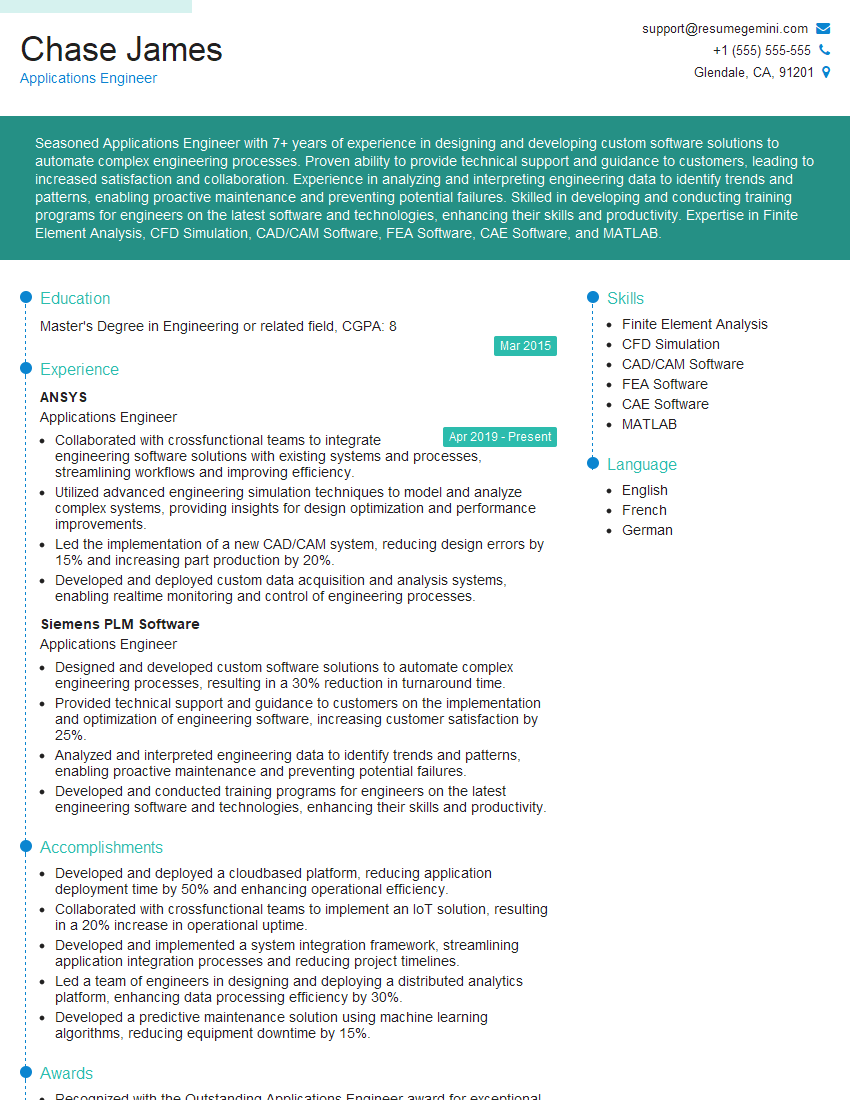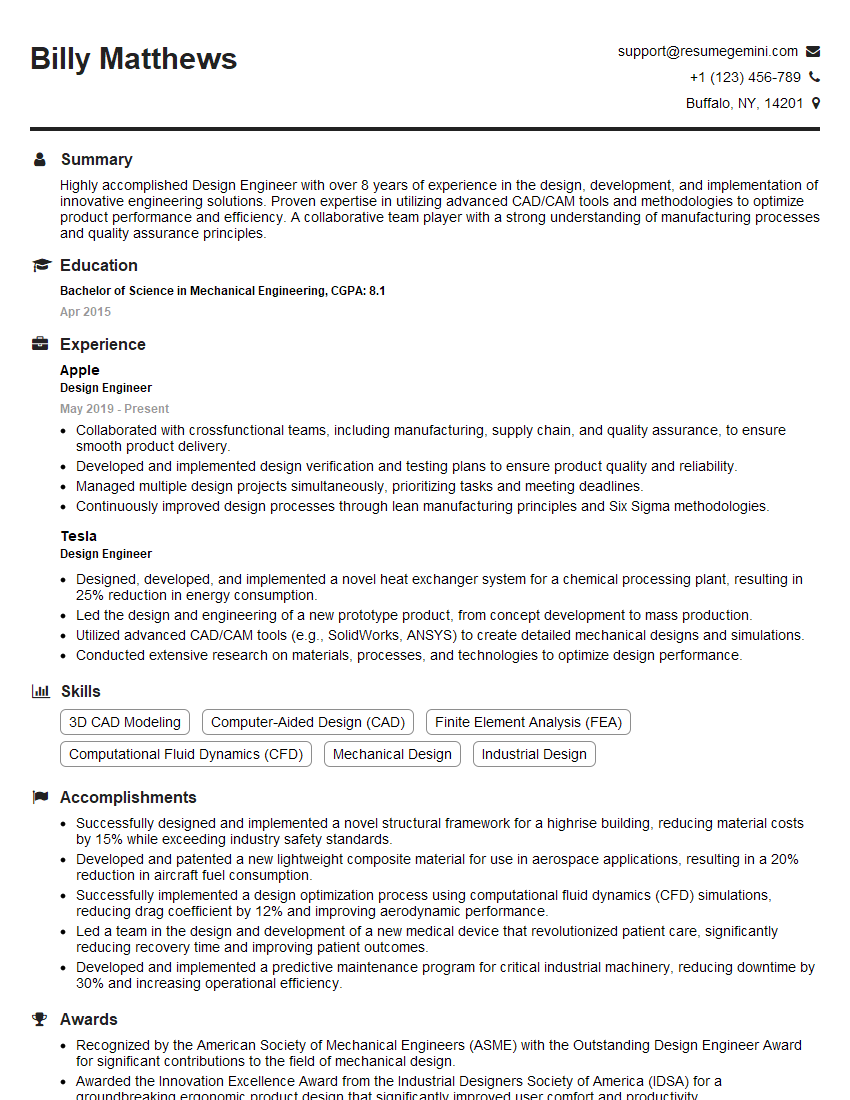Preparation is the key to success in any interview. In this post, we’ll explore crucial Vector Network Analysis (VNA) interview questions and equip you with strategies to craft impactful answers. Whether you’re a beginner or a pro, these tips will elevate your preparation.
Questions Asked in Vector Network Analysis (VNA) Interview
Q 1. Explain the principles of Vector Network Analysis.
Vector Network Analysis (VNA) is a powerful technique used to characterize the frequency response of linear circuits and components. It measures how a signal’s amplitude and phase change as it travels through a device or system across a wide range of frequencies. Unlike scalar network analyzers which only measure magnitude, VNAs measure both the magnitude and phase of the transmitted and reflected signals, providing a complete picture of the network’s behavior. This comprehensive information allows engineers to design and optimize circuits for performance, identify potential issues, and ensure reliable operation across different frequencies.
Imagine sending a wave down a string. A VNA is like observing how that wave changes – its amplitude (how big the wave is), and its phase (its position along the wave cycle) – at different points along the string. The string could represent a transmission line, and any changes in the wave reflect the characteristics of elements along that line (like components or imperfections).
Q 2. What are S-parameters, and how are they used in VNA measurements?
S-parameters, or scattering parameters, are a crucial part of VNA measurements. They describe how signals are scattered (reflected and transmitted) at the ports of a network. Each S-parameter represents a ratio of output to input power waves at specific ports, offering a quantitative description of the network’s behavior. For example, S11 represents the reflection coefficient at port 1, while S21 represents the transmission coefficient from port 1 to port 2. In a two-port network, a complete set of S-parameters (S11, S12, S21, S22) completely defines its behavior at a given frequency.
VNAs use these parameters to characterize devices like antennas, filters, amplifiers, and transmission lines. By measuring S-parameters across a range of frequencies, we obtain a detailed frequency response, helping identify resonance points, bandwidth limitations, and signal losses. This data is essential for designing efficient and reliable communication systems, radar systems, and many other applications.
Q 3. Describe the different types of VNA error correction techniques.
VNA error correction is crucial for obtaining accurate measurements because various systematic errors can affect the raw data. These techniques account for imperfections in the VNA’s test setup, such as cable losses, connector mismatch, and source and load mismatch.
- TRL (Thru-Reflect-Line): This is a common method that uses three calibration standards: a thru (a short, low-loss connection between ports), a reflect (a known reflection standard like a short circuit or open circuit), and a line (a transmission line of known electrical length). The VNA uses these measurements to model and remove systematic errors.
- SOL (Short-Open-Load): Similar to TRL, but uses a short circuit, an open circuit, and a matched load as calibration standards. It’s simpler but can be less accurate in certain scenarios.
- LRL (Line-Reflect-Line): This method is useful when the thru standard isn’t ideal or unavailable, often due to challenges in creating a perfect connection between ports.
- Custom Calibration Standards: For specialized applications or highly demanding accuracy requirements, custom calibration standards can be used, tailored to the specific characteristics of the device under test and the measurement environment.
These corrections ensure the measured S-parameters accurately represent the device’s characteristics, rather than being skewed by the measurement system itself.
Q 4. How do you calibrate a VNA?
Calibrating a VNA is essential to eliminate systematic errors and obtain accurate measurements. The calibration procedure involves connecting a set of known calibration standards (as described in error correction techniques) to the VNA’s ports and then using the VNA’s software to perform a calibration algorithm. This algorithm uses the responses from the standards to create an error model of the measurement system, which is then used to correct subsequent measurements. The steps generally involve connecting the calibration standards, initiating the calibration routine within the VNA software (selecting the appropriate calibration type such as TRL or SOL), and then saving the calibration data. It is often necessary to recalibrate regularly, especially after changing cables, connectors, or the measurement setup.
Choosing the right calibration method is important, and the choice depends on factors like frequency range, accuracy requirements, and the availability of calibration standards. A poorly calibrated VNA can lead to significant errors in the measured parameters.
Q 5. What are the common error sources in VNA measurements?
Several error sources can affect VNA measurements, compromising the accuracy of the results. These sources can be broadly categorized as systematic and random.
- Systematic Errors: These are repeatable errors caused by the measurement setup, including cable losses, connector mismatch, source and load impedance mismatches, and imperfections in the calibration standards. Proper calibration techniques are used to mitigate these errors.
- Random Errors: These are unpredictable errors due to noise, thermal variations, and other fluctuating factors. Averaging multiple measurements and improving the signal-to-noise ratio can help to reduce their impact.
- Environmental Factors: Temperature changes and electromagnetic interference (EMI) can also influence the measurements. Controlling the environment and shielding the setup is crucial for high-accuracy measurements.
- Frequency Response of Test Fixtures: The cables and connectors themselves have frequency-dependent effects, which must be carefully calibrated out. The longer the cable, the larger these effects become.
Understanding these error sources and implementing appropriate mitigation techniques is vital for obtaining reliable and accurate VNA measurements.
Q 6. Explain the difference between one-port and two-port measurements.
The difference between one-port and two-port measurements lies in the number of ports involved in the measurement.
- One-port measurements characterize a single port of a device, typically measuring the reflection coefficient (
S11). This is used to characterize the impedance or reflection properties of components like antennas, capacitors, or inductors. - Two-port measurements characterize a device with two ports (input and output). They provide a complete set of S-parameters (
S11,S12,S21,S22), allowing for analysis of parameters like transmission gain, reflection losses, and isolation. These are essential for characterizing networks like amplifiers, filters, and transmission lines.
For instance, you’d use one-port measurements to assess the reflection from an antenna, while two-port measurements would be used to evaluate an amplifier’s gain and signal loss across its input and output.
Q 7. How do you measure impedance using a VNA?
Impedance measurement using a VNA is based on the relationship between the reflection coefficient (S11) and the impedance. The VNA measures the reflection coefficient, and this data is then used to calculate the impedance using a simple formula based on the characteristic impedance of the system (typically 50 ohms). The formula is:
Z = Z0 * (1 + S11) / (1 - S11)
where Z is the impedance, Z0 is the characteristic impedance (often 50 ohms), and S11 is the reflection coefficient measured by the VNA. Accurate impedance measurements require proper calibration to eliminate error sources affecting S11 measurements, such as connector mismatch and cable losses. This ensures that the calculated impedance accurately represents the device under test, and not the measurement system itself. The process typically involves connecting the device under test to the VNA, performing a calibration, measuring the reflection coefficient at the desired frequency, and then using the formula above (or the VNA software) to calculate the impedance.
Q 8. How do you measure return loss using a VNA?
Return loss measures how much power is reflected back from a device or component compared to the power incident upon it. Think of it like a bouncer at a club – the higher the return loss, the fewer signals (power) are allowed in, and the more are reflected (bounced) back. A VNA measures this by sending a known signal into the device under test (DUT) and then measuring the amplitude of the reflected signal. The difference between the incident and reflected power is then expressed in decibels (dB).
To measure return loss using a VNA, you’ll typically connect the DUT to port 1 of the VNA using appropriate cables and connectors. The VNA then performs a S-parameter measurement, specifically S11, which represents the reflection coefficient at port 1. The return loss (RL) is calculated from S11 using the formula: RL (dB) = -20 * log10(|S11|). A high return loss (e.g., -30 dB) indicates a good match, meaning minimal reflection and efficient power transfer. Conversely, a low return loss indicates a poor match and significant reflection. You will typically see the results plotted against frequency to understand the return loss across the operating band of the DUT.
Q 9. How do you measure transmission loss using a VNA?
Transmission loss, also known as insertion loss, quantifies the reduction in signal power as it passes through a device or component. Imagine a water pipe – transmission loss represents the friction and leakage that reduces water flow. A VNA measures this by sending a known signal into one port and measuring the power level at another port. The difference in power levels represents the transmission loss.
To measure transmission loss using a VNA, the DUT is connected between port 1 and port 2. The VNA then measures the S-parameter S21 (or S12, depending on the direction of measurement), which represents the transmission coefficient. The transmission loss (TL) is calculated using the formula: TL (dB) = -20 * log10(|S21|). Again, a plot of TL versus frequency is typical to showcase the performance across a range of frequencies. Low transmission loss is desirable, indicating efficient signal transmission.
Q 10. Explain the concept of Smith charts and their application in VNA measurements.
Smith charts are graphical representations of impedance or reflection coefficient as a function of frequency. Think of it as a specialized map for RF engineers. They provide a visually intuitive way to analyze and design RF circuits. Each point on the chart represents a specific impedance value, and it’s particularly useful for visualizing impedance matching problems and transforming impedances.
In VNA measurements, the Smith chart allows for immediate visual interpretation of reflection coefficient data (S11). The reflection coefficient, determined by the VNA, is plotted on the Smith chart. This plot directly shows the impedance of the DUT at the measured frequency. The distance from the center of the chart indicates the magnitude of the reflection coefficient, while the angle indicates the phase. This helps quickly identify impedance mismatches, understand the impact of different components on impedance, and design matching networks to optimize power transfer. For instance, a point near the center represents a good impedance match, while a point near the periphery indicates a significant mismatch.
Q 11. What is the significance of frequency sweep in VNA measurements?
Frequency sweep is the process of systematically varying the frequency of the signal generated by the VNA. It’s crucial because the behavior of most RF components is frequency-dependent. Think of tuning a radio – you’re sweeping across frequencies to find the station you want. A simple fixed-frequency test only gives a snapshot of the performance at one point. A frequency sweep allows for a complete understanding of the component’s response across its entire operating range.
By performing a frequency sweep, you obtain a comprehensive picture of how return loss, transmission loss, phase, and other parameters change as a function of frequency. This helps identify resonant frequencies, bandwidth limitations, and other critical characteristics of the DUT. For example, a filter’s response can be accurately characterized by observing the passband and stopband regions across the swept frequency range. Without a frequency sweep, essential information about a component’s performance would be missed.
Q 12. Describe different types of VNA probes and their applications.
Various VNA probes are available, each designed for specific applications and measurement requirements. The choice of probe directly impacts the accuracy and suitability of the measurement.
- Coaxial probes: These are the most common type, used for general-purpose measurements on devices with coaxial connectors. They are relatively simple to use and are suitable for a wide range of frequencies.
- Open-ended probes: These probes are used to measure impedance on surfaces without direct physical contact, often useful for planar circuits or integrated circuits.
- Near-field probes: These probes are specialized for characterizing electromagnetic fields close to the DUT, useful in antenna characterization and electromagnetic compatibility (EMC) testing.
- Microscopic probes: Used for high-frequency measurements on very small features on integrated circuits.
The selection of the appropriate probe is vital for achieving accurate measurements. Using an improper probe can lead to inaccurate results and potentially damage the DUT or probe itself.
Q 13. How do you select the appropriate VNA for a specific application?
Selecting the right VNA depends on the specific application and required measurement accuracy. Key factors include:
- Frequency range: The VNA’s frequency range should cover the operating frequencies of the DUT.
- Dynamic range: Determines the VNA’s ability to measure both very large and very small signals, crucial for precise measurements across different signal levels.
- Accuracy: The measurement accuracy is critical, and higher accuracy often comes at a higher cost.
- Number of ports: The number of ports determines the type of measurements you can perform, such as 2-port or 4-port measurements for different scattering parameters.
- Test software capabilities: The software should offer the necessary analysis tools and support for various measurement types and report generation.
For example, a high-frequency application might require a VNA with a wide frequency range and high dynamic range, while a low-frequency application may only need a narrow frequency range and lower dynamic range. Careful consideration of these factors ensures the selection of a VNA that meets the application requirements and provides meaningful and reliable data.
Q 14. What are some common applications of VNA in various industries?
VNAs are essential tools across many industries, playing a critical role in various applications:
- Telecommunications: Characterizing filters, antennas, and other components in cellular base stations and communication systems.
- Aerospace and defense: Testing radar systems, satellite communication equipment, and other high-frequency components.
- Automotive: Analyzing high-speed data buses, sensors, and communication systems.
- Biomedical: Developing and testing medical implants and devices that operate at radio frequencies.
- Material science: Measuring the dielectric properties of materials at different frequencies.
In each case, VNAs offer precise and comprehensive data about the electrical characteristics of components and systems, which is crucial for design, development, testing, and troubleshooting. They ensure that devices meet performance specifications and reliability standards across their operating frequency range.
Q 15. Explain the concept of time-domain reflectometry (TDR) and its relation to VNA.
Time-domain reflectometry (TDR) is a technique used to locate and characterize discontinuities in transmission lines by analyzing the reflections of a pulse signal. Imagine throwing a ball at a wall; the ball reflects back, and the time it takes to return tells you the distance to the wall. Similarly, TDR sends a short electrical pulse down a transmission line. Any impedance mismatch (a change in the line’s characteristic impedance) causes a reflection, which is detected by the TDR. The time delay between the transmitted and reflected pulse is directly proportional to the distance to the discontinuity. The amplitude of the reflected pulse indicates the severity of the mismatch.
A Vector Network Analyzer (VNA) is a powerful instrument capable of performing TDR measurements. VNAs measure the scattering parameters (S-parameters) of a device or network over a range of frequencies. By performing a fast Fourier transform (FFT) on the time-domain response obtained from a step or pulse excitation, a VNA can derive the time-domain reflection characteristics, effectively acting as a TDR.
In essence, TDR is a specific application or measurement mode that can be performed with a VNA, offering a complementary time-domain perspective to the frequency-domain information the VNA typically provides.
Career Expert Tips:
- Ace those interviews! Prepare effectively by reviewing the Top 50 Most Common Interview Questions on ResumeGemini.
- Navigate your job search with confidence! Explore a wide range of Career Tips on ResumeGemini. Learn about common challenges and recommendations to overcome them.
- Craft the perfect resume! Master the Art of Resume Writing with ResumeGemini’s guide. Showcase your unique qualifications and achievements effectively.
- Don’t miss out on holiday savings! Build your dream resume with ResumeGemini’s ATS optimized templates.
Q 16. How do you interpret VNA measurement results?
Interpreting VNA measurement results involves analyzing the measured S-parameters (usually S11, S21, S12, S22 for a two-port network) displayed graphically or numerically. These parameters represent the reflection and transmission coefficients at various frequencies. For example, S11 (input reflection coefficient) shows how much of the incident signal is reflected back at the input port, while S21 (forward transmission coefficient) represents how much signal is transmitted from input to output. A low S11 indicates good impedance matching at the input, while a high S21 indicates high transmission efficiency.
The results are often presented as magnitude and phase plots against frequency. A high magnitude of S11 indicates significant reflections at a specific frequency, signifying a mismatch. Phase information reveals additional details about the nature of the mismatch, such as whether it’s capacitive or inductive. Experienced engineers look for characteristic signatures in these plots to identify specific issues, such as resonances, losses, or the location and nature of discontinuities.
Software provided with modern VNAs greatly assists in interpretation. Tools like Smith charts visually represent impedance and reflection coefficient, aiding in identification of impedance mismatches and providing a context for understanding the magnitude and phase information across frequency.
Q 17. Describe different types of discontinuities and their impact on VNA measurements.
Discontinuities in a transmission line are deviations from its uniform impedance. These create reflections that impact VNA measurements. Some common types include:
- Open Circuits: A complete break in the line; results in a large reflection (S11 close to 1) with a phase shift of 180 degrees.
- Short Circuits: Direct connection between the conductors; results in a large reflection (S11 close to -1) with a phase shift of 0 degrees.
- Impedance Mismatches: A sudden change in the characteristic impedance of the line. This is common at connectors or transitions between different transmission lines, leading to partial reflections whose magnitude depends on the degree of mismatch.
- Dielectric Changes: A change in the surrounding dielectric material impacts the characteristic impedance, causing reflections. This is often encountered in cabling that goes from air to other medium.
- Mechanical Damage: Bends, kinks, or damage to the physical structure of a transmission line, impacting impedance and causing reflections. These are often time-domain signatures.
The impact of these discontinuities on VNA measurements is the creation of reflection, attenuation and phase changes in the signals, which in turn affect the accuracy of measuring the characteristics of the system under test.
Q 18. How do you troubleshoot common problems encountered during VNA measurements?
Troubleshooting VNA measurements often involves a systematic approach:
- Calibration: Ensure proper calibration of the VNA using the appropriate calibration standards (e.g., open, short, load, and through). Incorrect calibration leads to inaccurate measurements.
- Connectors and Cables: Inspect connectors for damage and ensure good contact. Use high-quality cables with minimal losses. Air gaps in connectors severely impact the performance.
- Impedance Matching: Check that the impedance of the device under test (DUT) and the VNA system are properly matched. Mismatch leads to significant reflections and inaccurate results.
- Environmental Factors: Factors like temperature, humidity, and electromagnetic interference (EMI) can affect measurements. Control the environment as much as possible.
- Signal Integrity: Ensure signal integrity across the test setup; issues like excessive noise can mask important details in the measurements.
- Software Issues: Verify that the VNA software is properly configured and that the settings (like frequency range, power level, sweep speed) are appropriate for the measurement.
- Verification and comparison: If possible, compare the results to specifications or previous measurements to identify discrepancies. Use the VNA’s post-processing tools to filter noise or adjust the display settings to look for subtle effects.
Systematic debugging, along with a thorough understanding of transmission line theory and VNA operation, are critical for successful troubleshooting.
Q 19. Explain the importance of proper impedance matching in VNA measurements.
Proper impedance matching is crucial in VNA measurements because it minimizes reflections. When there’s a mismatch between the source impedance (VNA), the transmission line, and the load (DUT), reflected signals interfere with the transmitted signals, distorting the measured S-parameters. This leads to inaccurate measurements of the DUT’s characteristics.
Imagine trying to measure the performance of a water pump directly connected to a narrow pipe. The impedance mismatch at the pipe constriction would significantly affect the pump’s efficiency. In the same manner, impedance matching ensures that maximum power is transferred to the DUT and that the reflected signal is minimized so we get a true measurement of the DUT’s performance.
Ideally, all impedances should be 50 ohms (the standard in many RF systems), ensuring minimal reflections and maximizing power transfer.
Q 20. How do you handle mismatch errors in VNA measurements?
Mismatch errors in VNA measurements can be handled using several techniques:
- Impedance Matching Networks: Use matching networks (e.g., matching transformers, attenuators) to match the impedance of the DUT to the characteristic impedance of the transmission line (usually 50 ohms).
- Calibration Techniques: Advanced calibration techniques, like Error Correction, are used in VNAs to compensate for some mismatch errors. These calibrations (usually SOLT,TRL etc) account for systematic errors introduced by the test setup itself.
- De-embedding Techniques: If the DUT is embedded within a fixture, de-embedding techniques remove the effects of the fixture from the measured S-parameters, isolating the DUT’s response. This involves mathematical algorithms to separate DUT response from fixture effects.
- Simulation and Modeling: Simulating the test fixture helps anticipate and correct the impact of mismatches on VNA measurements before the actual test.
Careful design of the test fixture itself can significantly reduce mismatch problems. It is extremely important to use a well-defined and repeatable test setup.
Q 21. What are the limitations of VNA measurements?
VNA measurements have certain limitations:
- Frequency Range: VNAs have a limited frequency range, which restricts their use in certain applications requiring extremely high or low frequencies.
- Sensitivity and Dynamic Range: The sensitivity and dynamic range of a VNA are finite. This restricts their ability to measure very weak signals or large signal variations.
- Calibration Limits: Calibration errors can still introduce inaccuracies, even with advanced techniques. The calibration procedure only covers some system errors, not all of them.
- Non-linear Effects: VNAs primarily measure linear behavior. Strong non-linear effects in the DUT may not be accurately characterized.
- Measurement Time: High-resolution measurements can take a significant amount of time.
- Cost: High-performance VNAs are expensive.
Understanding these limitations helps engineers choose the appropriate VNA and interpret the results accordingly. For example, if a DUT has high non-linear behavior, another technique might be needed alongside the VNA, or a different VNA with suitable dynamic range and sensitivity needs to be chosen.
Q 22. Describe the difference between linear and logarithmic scales in VNA displays.
Vector Network Analyzers (VNAs) often display data using both linear and logarithmic scales, each offering unique advantages. A linear scale shows a direct, proportional relationship between the displayed value and the actual measured value. Think of a ruler: each increment represents an equal change in length. In a VNA, this might be used to display magnitude in volts or power in watts. It’s excellent for seeing small changes in a signal’s amplitude in a specific range, but it can become unwieldy when dealing with large dynamic ranges as the graph quickly becomes compressed.
A logarithmic scale, usually expressed in decibels (dB), compresses a wide range of values into a manageable display. Think of the Richter scale for earthquakes – a magnitude 6 earthquake is 10 times more powerful than a magnitude 5 earthquake. In VNAs, logarithmic scales (often dBm for power or dB for ratios like S-parameters) are crucial for visualizing measurements that span several orders of magnitude, such as return loss or gain across a broad frequency range. It allows us to clearly see both small and large changes simultaneously.
For example, a signal attenuation of 60dB (a factor of 1,000,000) would be barely visible on a linear scale but clearly identifiable as a distinct point on a logarithmic scale.
Q 23. Explain the concept of dynamic range in VNA measurements.
Dynamic range in VNA measurements refers to the difference between the strongest and weakest signals that the instrument can accurately measure. It’s a critical specification because it dictates the precision and sensitivity of your measurements. A high dynamic range means the VNA can measure both very strong and very weak signals without significant errors. Think of it like the range of a camera – a camera with a high dynamic range can capture both bright highlights and dark shadows without losing detail in either.
In a VNA, dynamic range is typically expressed in decibels (dB). A VNA with a 100dB dynamic range can accurately measure a signal 100dB weaker than the strongest signal it can handle. Factors influencing a VNA’s dynamic range include the noise floor (the inherent noise of the instrument) and the maximum input power the VNA can handle without saturation. Insufficient dynamic range can lead to inaccurate measurements, especially when dealing with signals with widely varying power levels. A low dynamic range might mask weak reflections or signals making analysis difficult. Ensuring you choose a VNA with an appropriate dynamic range for your application is essential to get reliable results.
Q 24. How do you perform noise figure measurements using a VNA?
Noise figure measurements using a VNA require specialized equipment and techniques. While a VNA doesn’t directly measure noise figure, it plays a crucial role in determining the noise parameters that are then used to calculate the noise figure. This typically involves using a noise source, a known standard, to inject calibrated noise into the device under test (DUT). The VNA measures the scattering parameters (S-parameters) both with and without the noise source. Then, using these measurements alongside the noise source’s parameters and equations derived from the equivalent noise model, the noise figure is calculated.
The process usually involves several steps, including:
- Connecting the noise source, DUT, and VNA in a calibrated setup.
- Measuring the S-parameters with the noise source ON and OFF across the frequency range of interest.
- Using specialized software or calculations to determine the noise parameters (e.g., noise source coefficient, equivalent noise resistance, etc.) This often involves noise temperature calculations using known noise source values.
- Finally, using these parameters along with the measured S-parameters in dedicated noise figure calculation software to get the noise figure (usually in dB).
The accuracy of the noise figure measurement heavily relies on proper calibration and the accuracy of the noise source used. It’s essential to follow the manufacturer’s instructions and use reliable calibration standards for precise results. Remember that this method allows us to assess the amount of noise added by the DUT.
Q 25. What is the role of a Vector Network Analyzer in antenna characterization?
A Vector Network Analyzer is indispensable for detailed antenna characterization. It allows us to measure various antenna parameters over a wide frequency range, providing crucial information for design, optimization, and performance verification. VNAs determine how an antenna radiates, receives, and interacts with electromagnetic fields.
Key antenna parameters measured using a VNA include:
- Return Loss (S11): Measures the power reflected back from the antenna, indicating impedance matching. A low return loss signifies good matching and efficient power transfer.
- Gain: Represents the antenna’s ability to amplify the received or transmitted signal in a specific direction.
- Radiation Pattern: Though not directly measured by the VNA alone, a combination of VNA and an antenna positioner allows mapping the antenna’s radiation characteristics over a full 3D or 2D sphere.
- Impedance: Characterizes the antenna’s electrical impedance at different frequencies, crucial for effective matching to the transmission line.
- Polarization: Describes the orientation of the electromagnetic field radiated by the antenna, either linear, circular or elliptical.
By analyzing these parameters, engineers can optimize antenna design, ensure proper impedance matching, and predict antenna performance in a real-world environment. For example, return loss measurements help verify that the antenna is efficiently transmitting power, avoiding losses due to reflections.
Q 26. How would you use a VNA to characterize a filter?
Characterizing a filter with a VNA involves measuring its frequency response, which details how the filter attenuates or passes signals at different frequencies. This is primarily done by measuring the filter’s S-parameters (scattering parameters).
The process generally involves:
- Calibration: The VNA needs to be calibrated accurately to remove errors introduced by the cables, connectors and test setup. This ensures the measurements reflect the filter’s properties, not artifacts from the test environment. Common calibration standards are short, open and load.
- Measurement Setup: Connect the filter between the VNA’s ports. Ensure a good, stable connection and minimal parasitic effects.
- S-parameter Measurement: The VNA measures the S-parameters (typically S21 for transmission and S11 for return loss) over the desired frequency range. S21 represents the signal’s amplitude and phase shift as it passes through the filter, showing the filter’s passband and stopband characteristics. S11 shows the reflection coefficient indicating how much signal is reflected rather than passed.
- Data Analysis: The measured S-parameters are then analyzed to determine key filter characteristics such as:
- Center Frequency: The frequency at which the filter has its maximum transmission.
- Bandwidth: The range of frequencies within which the filter passes signals with minimal attenuation.
- Insertion Loss: The attenuation of the signal in the passband.
- Rejection: The amount of attenuation in the stopband.
Analyzing these parameters allows engineers to verify the filter’s specifications and identify any deviations. For instance, observing high insertion loss in the passband could indicate issues with component quality or design flaws.
Q 27. Explain the difference between phase and group delay in VNA measurements.
Both phase delay and group delay are crucial for characterizing the time response of a device or system using a VNA. However, they represent different aspects of signal propagation.
Phase delay refers to the time it takes for a single frequency component (sine wave) of a signal to propagate through the system. It’s essentially the phase shift divided by the angular frequency. Think of it like the delay of a single runner in a race – how long it takes to complete the course, while ignoring all other runners. A constant phase delay across all frequencies implies that all frequency components arrive at the same time, which is ideal in many applications. VNAs measure the phase delay by analyzing the phase shift between the input and output signals for specific frequencies.
Group delay, in contrast, measures the time it takes for the *envelope* of a modulated signal (containing multiple frequencies) to travel through a system. This represents the time delay experienced by information being carried by the modulated signal, reflecting how quickly the group of frequencies propagates. It’s more relevant when considering signals with multiple frequencies, like a modulated carrier signal. Think of it as the average time it takes for a group of runners to complete the course. A constant group delay across the frequency range is desired in many applications, especially those that transmit data or information since all frequency components comprising the signal need to arrive in a synchronous manner. It’s obtained from the derivative of the phase response with respect to frequency.
In short, phase delay focuses on individual frequencies, while group delay focuses on the overall group of frequencies in a signal. Disparities between phase and group delay can indicate signal distortion or dispersion in a system.
Q 28. How would you debug a faulty VNA measurement setup?
Debugging a faulty VNA measurement setup requires a systematic approach. The process should be step-wise and involves checking both hardware and software aspects.
Here’s a structured troubleshooting guide:
- Verify Connections: Start by carefully inspecting all connections between the VNA, DUT (Device Under Test), and any other components in the setup. Loose connectors or incorrect wiring are common sources of errors. Ensure all cables are correctly connected and of appropriate impedance for the measurements.
- Check Calibration: Improper or outdated calibration is a major cause of inaccurate measurements. Perform a full calibration of the VNA using appropriate standards (short, open, load) to remove any systematic errors introduced by the measurement setup.
- Inspect the DUT: A faulty DUT can produce incorrect results. Check for any physical damage to the DUT and ensure it’s properly connected and functioning as expected. Inspect the DUT’s connectors and wiring for any continuity issues or open circuits.
- Examine the Test Setup: Parasitic elements in the test setup, like excessive cable length or poor grounding, can introduce errors. Minimize cable length, ensure good grounding, and use appropriate shielding to reduce these effects.
- Software Verification: Verify that the VNA’s software settings (such as the frequency range, sweep type, power levels, etc.) are correctly configured for the intended measurement. Check for any error messages or warnings displayed by the software.
- Reference Measurements: Perform measurements on a known good device or component to compare against your DUT’s results. This helps validate the measurement setup and identify any systematic inconsistencies.
- Repeatability: Repeat the measurements several times to check for repeatability. Inconsistent results suggest an instability in the setup or a faulty component.
- Consult Documentation: Refer to the VNA’s manual and troubleshooting guides for potential problems and solutions related to your specific setup.
By systematically checking these aspects, you can isolate the source of error and correct the faulty VNA measurement setup.
Key Topics to Learn for Vector Network Analysis (VNA) Interview
- S-parameters: Understanding the definition, interpretation, and practical significance of S-parameters (S11, S21, etc.) in characterizing two-port networks. Consider how they relate to reflection and transmission coefficients.
- Network Representations: Familiarity with different network representations (e.g., impedance, admittance) and the ability to convert between them. Practice analyzing simple and complex circuits using these representations.
- Calibration Techniques: Mastering various calibration methods (e.g., SOLT, TRL) used to eliminate systematic errors and improve the accuracy of VNA measurements. Understand the underlying principles and limitations of each technique.
- Error Correction: Understanding the sources of measurement errors in VNA systems and the methods employed for their correction. This includes systematic and random errors.
- Practical Applications: Explore the applications of VNA in various fields, such as antenna characterization, filter design, high-frequency circuit testing, and material characterization. Be ready to discuss specific examples.
- Smith Charts: Proficiently using Smith charts for impedance matching, visualizing reflection coefficients, and understanding transmission line behavior. Be prepared to interpret Smith chart data.
- Measurement Techniques: Develop a strong understanding of different measurement techniques used with VNAs, including frequency sweeps, time-domain measurements, and network analysis techniques.
- Troubleshooting: Develop skills in troubleshooting common problems encountered during VNA measurements, such as impedance mismatches, connector issues, and spurious signals.
Next Steps
Mastering Vector Network Analysis (VNA) is crucial for career advancement in fields like RF engineering, telecommunications, and microwave technology. A strong understanding of VNA principles and applications demonstrates valuable expertise and opens doors to exciting opportunities. To maximize your job prospects, focus on crafting an ATS-friendly resume that highlights your skills and experience effectively. ResumeGemini is a trusted resource to help you build a professional resume that stands out. Examples of resumes tailored to Vector Network Analysis (VNA) roles are provided to guide you.
Explore more articles
Users Rating of Our Blogs
Share Your Experience
We value your feedback! Please rate our content and share your thoughts (optional).
What Readers Say About Our Blog
Hi, I represent an SEO company that specialises in getting you AI citations and higher rankings on Google. I’d like to offer you a 100% free SEO audit for your website. Would you be interested?
good
















